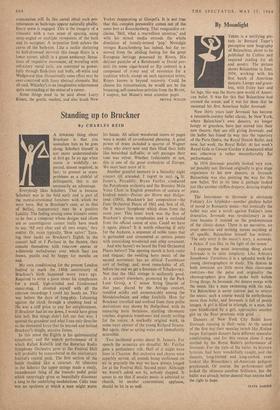By Moonlight
THERE is a terrifying pic- ture in Bernard Taper's
perceptive new biography of Balanchine, about to be published by Collins and required reading for all and sundry. The picture shows Balanchine in June, 1934, working with his first batch of American dancers. Lumpy and grace-
less, with frizzy hair and fat legs, this was the brave new world of Ameri- can ballet. It was for this that Balanchine had crossed the ocean, and it was for them that he mounted his first American ballet Serenade.
Now thirty years later Serenade has become a twentieth-century ballet classic. In New York, where Balanchine's own dancers, no longer
lumpy or graceless, have just moved into their
new theatre, they are still giving Serenade, and the ballet has found its way into the repertory of the Paris Opera, the Royal Danish Ballet, and now, last week, the Royal Ballet. At last week's Royal Gala at Covent Garden it dominated what was otherwise a rather uncomfortably flat performance.
In 1934 Serenade possibly looked very new, yet possibly not. Devised originally to give stage experience to his new dancers, in Serenade Balanchine was also pointing the way for the new ballet. Yet in its time it perhaps looked just like another chiffon-drapery, dancing-display piece.
The forerunner to Serenade is obviously Fokine's Les Sylphides—another plotless ballet
of mood to Romantic music—but ironically the
ballet was also a revolt against Fokine's later dramatics. Serenade was revolutionary in its
time because it insisted on the predominance of the classic dance. There is no narrative, no overt emotion and nothing means anything at all specific. Balanchine himself has written: The only story is the music's story, a serenade, a dance, if you like, in the light of the moon.'
I suppose the most interesting thing about Serenade is its utter simplicity. Like Ashton's Symphonic Variations it is a splendid work for
young choreographers to study. The dances in both instances are little more than classroom exercises—but the pulse and originality the
choreographers give them make both ballets living things. In Serenade, the dances merge with
the music like a man swimming with the tide.
Yet Balanchine is never content just to mirror the music; such a course would be eurhythmics
more than ballet, and Serenade is full of poetic images. A girl is lifted in triumph, or a man, his eyes blindfolded by a girl, approaches another girl on the floor prostrate with grief.
Dancers of New York City Ballet have Serenade running in their veins. At the sound of the first bar their muscles twitch like lEolian harps. European dancers have different muscular conditioning, and for this reason alone I was startled by the Royal Ballet's performance of Serenade. For the style of the ballet, its bravura lyricism, had been wonderfully caught, and the dancers, long-limbed and long-necked, even looked like Balanchine's all-American pedigree greyhounds. Of course, the performance still lacked the ultimate carefree brilliance, but the ballet was already better danced than anyone had the right to hope.
CLIVE BARNES






























 Previous page
Previous page